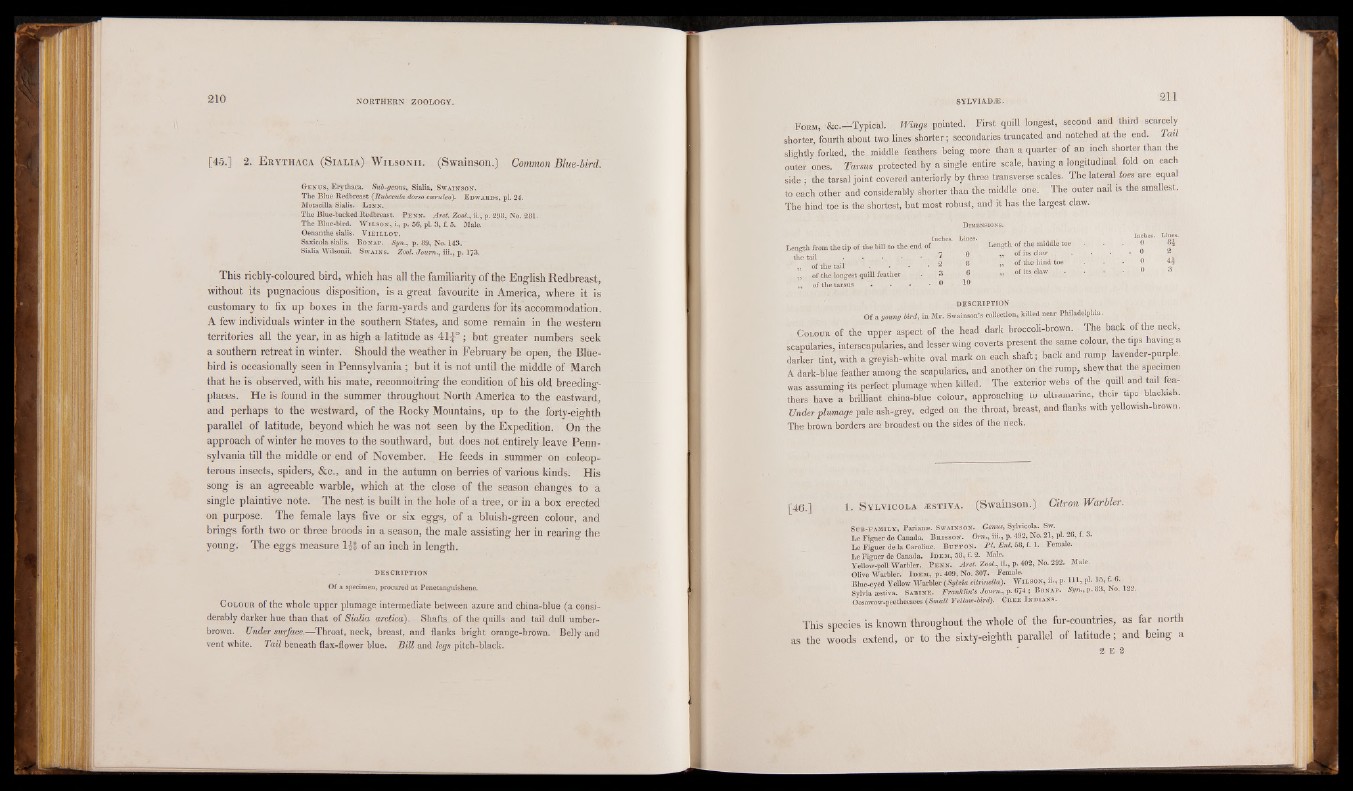
[45j§.; 2. E rythaca (Sialia) Wilsonii. (Swainson.) Common Blue-bird.
Ge n u s , Erythaca. Sub-genus, Sialia, Sw a in s o n .
The Blue Redbreast (Rubecula dorso coeruleo). E dw a rds, pi. 24.
Motacilla Sialis. L in n .
The Blue-backed Redbreast. P e n n . Arct. Zool., ii., p. 298, No. 281.
The Blue-bird. W il s o n , i., p. 56, pi. 3, f. 5. Male.
Oenauthe sialis. Vie il l o t .
Saxicola sialis. B o na p. Syn., p. 89, No. 143.
Sialia Wilsonii. Sw a in s . Zool. Journ., iii., p. 173.
This richly-coloured bird, which has all the familiarity of the English Redbreast,
without its pugnacious disposition, is a great favourite in America, where it is
customary to fix up boxes in the farm-yards and gardens for its accommodation.
A few individuals winter in the southern States, and some remain in the western
territories all the year, in as high a latitude as 41J°; but greater numbers seek
a southern retreat in winter. Should the weather in February be open, the Bluebird
is occasionally seen in Pennsylvania ; but it is not until the middle of March
that he is observed, with his mate, reconnoitring the condition of his old breeding-
places. He is found in the summer throughout North America to the eastward
and perhaps to the westward, of the Rocky Mountains, up to the forty-eighth
parallel of latitude, beyond which he was not seen by the Expedition. On the
approach of winter he moves to the southward, but does not entirely leave Pennsylvania
till the middle or end of November. He feeds in summer on coleopterous
insects, spiders, &c., and in the autumn on berries of various kinds. His
song is an agreeable warble, which at the close of the season changes to a
single plaintive note. The nest is built in the hole of a tree, or in a box erected
on purpose. The female lays five or six eggs, of a bluish-green colour, and
brings forth two or three broods in a season, the male assisting her in rearing the
young. The eggs measure H" of an inch in length.
DESCRIPTION
Of a specimen, procured at Penetanguishene.
C olour of the whole upper plumage intermediate between azure and china-blue (a considerably
darker hue than that of Sialia arctica). Shafts, of the quills and tail dull umber-
brown. Under surface.—Throat, neck, breast, and flanks bright orange-brown. Belly and
vent white. Tail beneath flax-flower blue. Bill and legs pitch-black.
, F orm, &c.—Typical.' Wings pointed. First 'quill longest, second and third scarcely
shorter, fourth about two lines shorter; secondaries truncated and notched at the end. Tail
slightly forked, the middle feathers being more than a quarter of an inch shorter than the
outer , ones. Tarsus, protected by a single entire scale, having a longitudinal fold on each
side ; the tarsal joint covered anteriorly by three transverse scales. The lateral ioe» are equal
to each other and considerably shorter than the middle one. The outer nad is the smallest.
The hind toe is the shortest, but most robust, and it has the largest claw.
Length from the tip of the bill to the end ofI nches. Lines. Length of the middle toe
HthIe t a i l .........................................I -7 0 „ of its daw I of the tail • * 2 8 - „ of the hind toe
„ of the. longest guill feather . 3 6 of its claw .
„ ’ of the tarsus ’. • • . 0 10
DESCRIPTION
Of a young bird, in Mr. Swainson’s collection, killed near Philadelphia.
Inches. Lines.
0 8|
00 24A 0 3
C olour of the upper aspect of the head dark broccoli-brown. The back of the neck,
scapülaries, interscapularies, and lesser wing coverts present the same colour, the tips having a
darker tint, with a greyish-white oval mark on each shaft.; hack and rump lavender-purple. A dark-bine feather among the scapularies, and another on the rump, shew that the specimen
was assuming its perfect plumage when killed. The exterior webs of the quill and tad feathers
have a brilliant china-bine colour, approaching to ultramarine, their tips blackish.
Under plumage pale ash-grey, edged on the throat, breast, and flanks with yellowish-brown.
The brown borders are broadest on the sides of the neck.
[46.] 1. Sylvicola asstiva. (Swainson.) Citron Warbler.
S u b -f a m i l y , Parian». S w a in s o n . Genus, Sylvicola. Sw.
L e Figuer de Canada. B r is so n . Om ., iii., p. 492, No. 21, pi. 26, f. 3.
Le Figuer de la Caroline. Buffo n. PI. Enl. 58, f. 1. Female.
Le Figuer de Canada. Idem, 58, f. 2. Male.
Yellow-poll Warbler.. P enn. Arct. Zool., ii., p. 402, No. 292. Male.
Olive Warbler. Idem, p. 409, No. 307- Female.
Blue-eyed Yellow Warbler (Sylvia citrinelld). W il s o n , ii., p. I l l , pL 15,
Sylvia aestiva. Sa b in e . Franklin’s Joum., p. 674 ; B o n a p. Syn., p. 83, No. 122.
Oosowow-peetheesees (Small Yellow-bird). Cr e e I n d ia n s .
This species is known throughout the whole of the fur-countries, as far north
as the woods extend, or to the sixty-eighth parallel of latitude; and being a
2 E 2